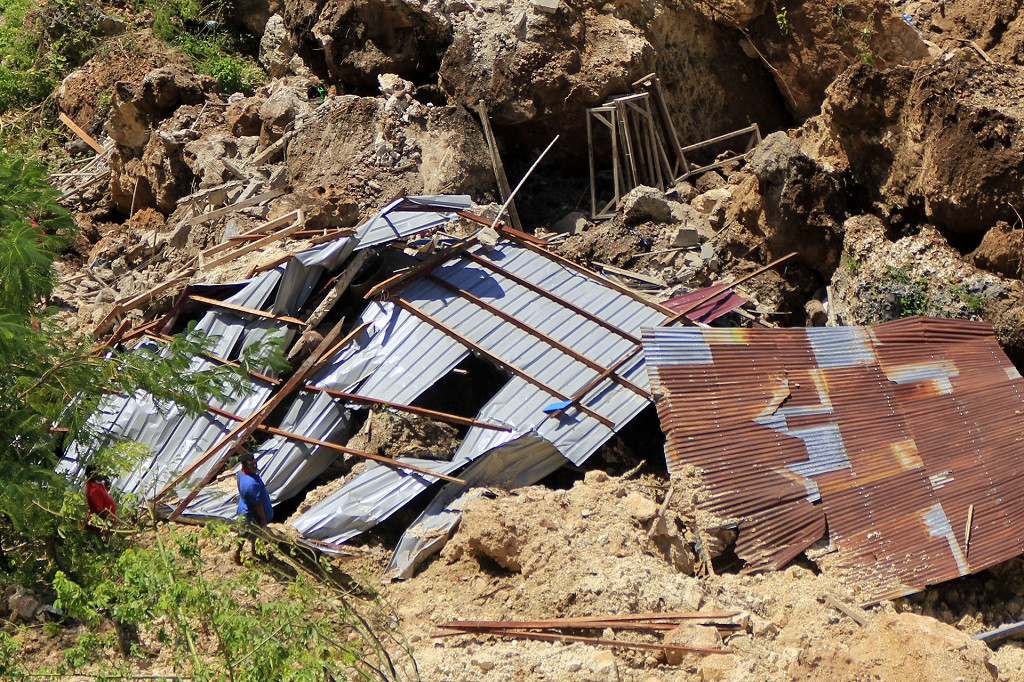Popular Reads
Top Results
Can't find what you're looking for?
View all search resultsPopular Reads
Top Results
Can't find what you're looking for?
View all search resultsBNPB steps up focus on climate crisis
The National Disaster Mitigation Agency (BNPB) and the Environment and Forestry Ministry are coordinating to include climate crisis adaptation in the country's disaster mitigation system, following a recent surge in deadly hydrometeorological disasters.
Change text size
Gift Premium Articles
to Anyone
T
he government will include climate crisis adaptation in every effort to mitigate disasters across the country as the archipelago is projected to see an increase in the number of climate-related natural disasters in the coming years.
National Disaster Mitigation Agency (BNPB) prevention division deputy head Lilik Kurniawan said authorities were looking more into the effect of the climate crisis on natural disasters, especially following a series of disasters in East Nusa Tenggara presumably caused by Tropical Cyclone Seroja.
The Meteorological, Climatology and Geophysics Agency (BMKG) recorded Seroja as the strongest tropical cyclone Indonesia had seen since 2008. Agency head Dwikorita Karnawati said the cyclone was an “unusual” occurrence because its center reached land even as it first appeared, probably caused by the average sea temperature increase.
The cyclone also hit East Nusa Tenggara and neighboring West Nusa Tenggara, regions rarely affected by cyclones in past years. Seroja is believed to have triggered widespread flooding and landslides in East Nusa Tenggara and West Nusa Tenggara. Nearly 200 lost their lives during the disasters, which also displaced thousands of local residents.
“Climate change has become an emerging threat in disaster mitigation,” Lilik said in a recent discussion.
Read also: Indonesia braces for more weather disasters. Climate crisis will make them worse.
Although he did not reveal any details on how the agency would include climate adaptation measures in disaster mitigation, Lilik said the BNPB would work with the Environment and Forestry Ministry, which has a directorate dedicated to adaptation efforts.
Such measures were also in line with the Yogyakarta Declaration on disaster risk reduction in Asia and the Pacific. The declaration was made at the 2012 Asian Ministerial Conference on Disaster Risk Reduction (AMCDRR). During the conference, 55 Asia Pacific countries recognized a necessity to include disaster risk mitigation and climate change adaptation in national development.
“Disaster mitigation is already a form of climate change adaptation. However, if we previously only took into consideration the historical trend of disasters, we also calculate future conditions pertaining to the climate, such as greenhouse gas emissions,” Environment and Forestry Ministry climate change adaptation director Sri Tantri Arundhati told The Jakarta Post on Friday.
Lilik acknowledged that 95 percent of hydrometeorological disasters occurring in the country were related to the climate. The worsening climate crisis had made the disasters more intense and frequent over the years.
The BNPB recorded a rise in the number of hydrometeorological disasters from 2015 to 2020, which were also the six hottest years on record according to the World Meteorological Organization (WMO). The country saw around 1,664 disasters in 2015, but the figure rose to 3,800 in 2019.
Based on the climate risk assessment carried out by the ministry, the BNPB will update the risk factors of each village and subdistrict in the country.
An earlier assessment revealed that more than 53,000 villages and subdistricts across the archipelago were located in disaster prone areas, putting the lives of 51 million people at risk.
The updated risk assessment will be compiled and made available on online and mobile applications issued by the disaster agency. This will be a part of efforts to communicate the disaster and climate risk to the people.
Lilik said the BNPB would also engage local civil society groups that have a strong presence in the community and understanding of local wisdom to participate in mitigating disasters in the area, including those related to the climate.
Tantri said climate change adaptation efforts might vary by location due to their respective conditions. A 2018 environment and forestry ministerial regulation mandates authorities to conduct further studies on a region’s risk and vulnerability to the impact of climate changes before making any decisions on potential intervention.
Despite the importance, the government had been allocating limited funding to such studies, hindering them from conducting the studies and working on adaptation efforts in all high-risk areas, Tantri said. Pilot projects in several regions, such as Southeast Sulawesi, Maluku and East Nusa Tenggara, were done under the support of international sponsors.
Ninil Jannah of the National Platform for Disaster Risk Reduction (Planas PRB) urged the government to work on climate adaptation as soon as possible as the climate crisis had affected the archipelago.
She added that the BNPB and the ministry had yet to properly align their points of view on disaster mitigation and climate adaptation. While the disaster agency still relied on the historical record of past disasters, the ministry heavily relied on projections of future climate conditions.
The current approach to disaster mitigation and climate crisis adaptation had also yet to take root in local wisdom and traditions, while communities were still unequipped to face the worsening crisis, she said.
“We still tend to use a top-down approach to disaster mitigation and climate adaptation,” Ninil said.
Read also: Indonesia mulls net-zero emissions target by 2070
Environmentalists have criticized the government for not being ambitious enough in mitigating the climate crisis.
While every country signing the Paris Climate Agreement in 2015 is required to update their climate pledge every five years, Indonesia has decided to keep its previous climate pledge of a 29 percent reduction in greenhouse gas emissions independently, or 41 percent with international assistance, by 2030.
The government also recently communicated a plan to adopt a net-zero emissions target by 2070. However, recent studies suggest that countries will need to reach a net-zero target for all greenhouse gases emissions by 2068 at the latest in order to limit the warming below 1.5 degrees Celsius.










